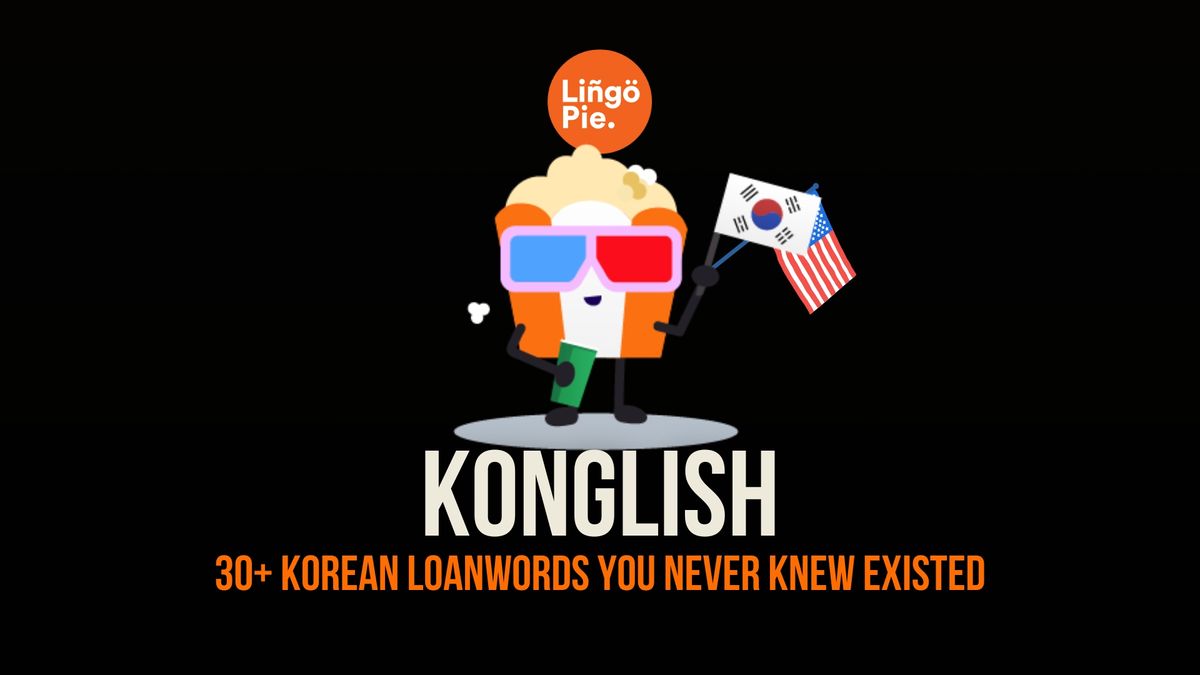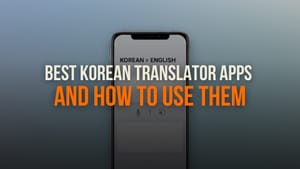If you've watched even a handful of Korean dramas, you've definitely encountered that one character who studied abroad and can't help but pepper their speech with English words. Usually, it's the rich chaebol heir who just returned from the US, casually dropping phrases with a mix of Korean and English known as Konglish.
In this post, I'll introduce you to over 30 Konglish words or Korean loanwords you’ve probably encountered without realizing their Korean connection. By the end, you'll discover how these familiar-sounding terms have been transformed with new pronunciations and sometimes completely different meanings as they’ve been incorporated into Korean culture.

What Is Konglish?
Konglish is a unique blend of Korean and English found throughout South Korea. In its simplest definition, Konglish refers to English loanwords that have been adapted into Korean, including many English words that are used in ways not readily understandable to native English speakers.
Unlike code-switching, which implies true bilingualism, Konglish represents a process of nativization—English words being absorbed and transformed within the Korean language and culture. These borrowed English words often take on new meanings, pronunciations, and uses that reflect Korea's unique cultural context.
Today, Konglish is everywhere: in advertisements, product names, casual conversation, and yes, those K-dramas you've been binging.
Konglish Vs. Korean Loanwords
Korean words derived from English fall into two distinct categories: Korean loanwords and Konglish words. Korean loanwords are English terms that have been directly adopted into standard Korean vocabulary with minimal changes beyond pronunciation, maintaining their original meanings.
Konglish words, however, are creative adaptations that have either combined English words in new ways or given English words completely different meanings within Korean culture.
Let's get to know each in the sections below.
Korean Loanwords - 외래어
Korean loanwords (also known as oeraeeo) serve as straightforward translations that maintain semantic equivalence with their English origins. While they may sound slightly different due to Korean phonetics, their meanings remain unchanged, creating convenient "bridges" between the two languages.
Examples of Korean Loanwords:
- 텔레비전 (tellebijeon) - "television"
- 커피 (keopi) - "coffee"
- 택시 (taeksi) - "taxi"
- 호텔 (hotel) - "hotel"
- 버스 (beoseu) - "bus"
- 컴퓨터 (keompyuteo) - "computer"
- 아파트 (apateu) - "apartment"
- 티켓 (tiket) - "ticket"
- 바나나 (banana) - "banana"
- 레스토랑 (leseutolang) - "restaurant"
Konglish Words
Konglish words represent a more creative linguistic transformation, where English terms undergo significant changes in meaning, structure, or usage patterns. Usually, Konglish words emerge through abbreviation (shortening lengthy English terms), combination (merging multiple English words into new compounds), or semantic shift (assigning entirely new meanings to existing English words).
Examples of Konglish Words:
- 핸드폰 (haendeupon) - "hand phone" (mobile phone)
- 아이쇼핑 (aisyoping) - "eye shopping" (window shopping)
- 원룸 (wonrum) - "one room" (studio apartment)
- 오피스텔 (opiseutel) - combination of "office" and "hotel" (small office/residential space)
- 화이팅 (hwaiting) - sounds like "fighting" but means "good luck" or "you can do it!"
- 샐러리맨 (saelleolimaen) - "salary man" (office worker)
- 마라톤 미팅 (maraton miting) - "marathon meeting" (lengthy meeting)
- 백미러 (baekmileo) - "back mirror" (rearview mirror)
- 스킨십 (seukinsip) - "skinship" (physical touch/affection)
- 셀카 (selka) - shortened from "self camera" (selfie)
Popular Konglish Words
For K-drama fans, recognizing these common Konglish terms can enhance your viewing experience and give you those satisfying moments of understanding dialogue before the subtitles appear. To help you get started, here are some of the most frequently used Konglish words you’ll encounter in popular Korean shows:
| Konglish Word | Pronunciation | Meaning in Korean | Example Usage in K-dramas |
|---|---|---|---|
| 메뉴 (menyu) | men-yu | "menu" | Often heard in cafe or restaurant scenes |
| 바이러스 (baireoseu) | bai-reo-seu | "virus" | Used in medical or thriller K-dramas |
| 매니저 (maenijeo) | mae-ni-jeo | "manager" | Common in entertainment industry storylines |
| 디테일 (diteil) | di-te-il | "detail" | Often used by perfectionist characters |
| 코디 (kodi) | ko-di | "coordinator" | Used for fashion stylists in celebrity-themed dramas |
| 노트북 (noteubook) | no-teu-book | "laptop" (not notebook) | Seen in office and student scenes |
| 아파트 (apateu) | a-pa-teu | "apartment" | Frequently mentioned in housing discussions |
| 서프라이즈 (seopeuraiseu) | seo-peu-ra-i-seu | "surprise" | Used in birthday or proposal scenes |
| 러브라인 (reobeurain) | reo-beu-ra-in | "love line" | Describes romantic relationship development |
| 스킨십 (seukinsip) | seu-kin-sip | "skinship" | Physical touch between couples or friends |
| 오픈마인드 (openmaindu) | o-pen-ma-in-du | "open-minded" | Used when discussing progressive viewpoints |
| 썸 (sseom) | sseom | "something" | Describes an undefined romantic relationship |
| 더블 (deobeur) | deo-beul | "double" | Often used for "double date" or "double check" |
| 패스 (paeseu) | pae-seu | "pass" | Used when declining an offer or suggestion |
| 팬서비스 (paenseobiseu) | paen-seo-bi-seu | "fan service" | Actions performed specifically to please fans |
| 치맥 (chimaek) | chi-maek | "chicken + beer" | Popular food combination in social scenes |
| 스트레스 (seuteuresseu) | seu-teu-re-seu | "stress" | Frequently mentioned in workplace dramas |
| 버킷리스트 (beokitriseuteu) | beo-kit-ri-seu-teu | "bucket list" | Goals before a character dies or changes life |
These Konglish words are particularly useful as they repeatedly appear across different K-drama genres. Listen for them during your next binge-watching session, and you might be surprised at how quickly you will start recognizing them without relying on subtitles!
- 6 Best Korean Reality Shows On Netflix Worth Losing Sleep Over
- 12 Korean Horror Movies You Need To Watch Alone
- Here's How To Learn Korean with Netflix's Single's Inferno
How To Use Konglish Words Effectively
Learning to use Konglish naturally can enhance your Korean language skills and help you connect with native speakers. Konglish words are most appropriate in casual, everyday conversations rather than formal situations. They’re commonly used:
- In daily conversations - Many Konglish terms are so integrated into modern Korean that they're used without a second thought in everyday speech
- In social media and texting - Abbreviated Konglish terms are especially popular in digital communication
- In casual business settings - Terms like 프로젝트 (peurojekteu, "project") and 미팅 (miting, "meeting") are standard even in professional environments
- With younger Koreans - The younger generation typically uses more Konglish expressions than older Koreans
Remember that in very formal settings, traditional Korean equivalents might be preferred, especially in government documents, academic papers, or formal speeches.
When it comes to pronunciation, remember that Konglish follows Korean phonetic patterns, which differ significantly from English:
- Add vowels between consonant clusters - English often has consecutive consonants that Korean doesn't allow, so vowels are inserted (e.g., "strike" becomes 스트라이크 (seuteulaike))
- Replace English sounds that don't exist in Korean - For example, "f" becomes "p" (coffee → 커피, keopi)
- Follow Korean stress patterns - Korean generally doesn't emphasize syllables the way English does
- Pay attention to final consonants - Korean has strict rules about which consonants can end a syllable
Our advice? Listen carefully to how Korean speakers pronounce these words rather than assuming they'll sound like English with an accent.
Discover Korean Through Konglish with Lingopie
Now that you've got a handle on Konglish and how it bridges the gap between Korean and English, you're already one step ahead in your Korean language journey. But recognizing these words is just the beginning!
This is where Lingopie comes in.
Unlike traditional language learning apps, Lingopie uses actual Korean TV shows and movies as your classroom, allowing you to hear Konglish words and standard Korean vocabulary in authentic contexts. When you encounter a Konglish word like "셀카" (selka) or "치맥" (chimaek) in popular shows like the Squid Game, you can click on it to see its meaning, save it to your vocabulary list, and hear how native speakers naturally incorporate it into conversations.
The best part? You're learning while being entertained by the same K-dramas you already love watching. So why not turn your K-drama obsession into actual language lessons? Start catching those Konglish words in action, and watch as your Korean vocabulary grows episode by episode with Lingopie.







![Korean Onomatopoeia: 80+ Sounds And Mimetic Words [Guide]](/blog/content/images/size/w300/2025/12/Korean-onomatopoeia.jpg)

